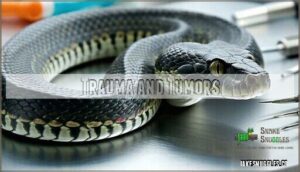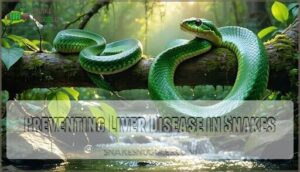This site is supported by our readers. We may earn a commission, at no cost to you, if you purchase through links.

Signs include lethargy, loss of appetite, yellow discoloration (jaundice), weight loss, and swollen abdomen.
Liver failure can be acute or chronic, stemming from fatty liver disease, infections, toxins, poor nutrition, or trauma.
Early diagnosis through blood tests and imaging is essential for treatment success.
Supportive care includes fluid therapy, medications, and addressing underlying causes.
The prognosis depends on severity and how quickly treatment begins.
Understanding the warning signs and proper care techniques can make the difference between recovery and loss.
Table Of Contents
- Key Takeaways
- Recognizing Liver Failure in Snakes
- Causes of Liver Failure in Snakes
- Diagnosing Liver Disease in Snakes
- Treatment Options for Liver Failure in Snakes
- Preventing Liver Disease in Snakes
- Complications of Liver Failure in Snakes
- Prognosis and Survival Rate for Snakes With Liver Failure
- Managing Liver Disease in Snakes at Home
- Common Co-Existing Conditions in Snakes With Liver Failure
- Frequently Asked Questions (FAQs)
- What should a veterinarian do if a reptile has liver disease?
- What diseases does a snake have?
- How does fatty liver disease affect reptiles?
- What causes a snake to vomit after eating?
- What are common snake conditions?
- What are the symptoms of liver failure in snakes?
- Can liver failure be treated?
- What is the end of liver failure?
- Can liver failure be reversed?
- What are the final symptoms of end stage liver disease?
- Conclusion
Key Takeaways
- Recognize warning signs early – Watch for yellowing skin, lethargy, appetite loss, and yellow-green urates, as these symptoms indicate serious liver compromise requiring immediate veterinary attention.
- Seek emergency veterinary care – Do not wait when you notice symptoms, since liver failure progresses rapidly and early intervention dramatically improves your snake’s survival rates from poor to 75-90%.
- Address underlying causes – Work with your vet to identify what is causing the liver failure, whether it is overfeeding, infections, toxins, or poor husbandry, since treating the root cause is essential for recovery.
- Provide supportive home care – Create a stress-free environment with proper temperatures, minimal handling, and strict medication schedules, while monitoring your snake’s progress closely for any changes.
Recognizing Liver Failure in Snakes
You’ll notice liver failure symptoms develop differently in snakes, ranging from subtle changes to life-threatening emergencies.
Early recognition can mean the difference between successful treatment and losing your beloved pet, so understanding these warning signs is essential for any snake owner, as it can lead to successful treatment.
Common Symptoms of Liver Failure
Why would your snake suddenly start refusing food and acting sluggish? Recognizing snake liver failure symptoms early can save your pet’s life. Liver disease often develops silently until it becomes severe.
Watch for these key warning signs:
- Appetite loss and weight loss over weeks or months
- Jaundice/icterus showing as yellowing skin or eyes
- Yellow-green urates indicating severe liver compromise
- Abdominal swelling from fluid buildup or enlarged organs
- Altered mentation like head pressing, circling, or seizures
Snake liver disease can mimic other snake health issues, making diagnosis tricky. Your snake might also show lethargy, vomiting, or unusual behavior changes. Addressing potential issues like infectious stomatitis is essential for proper diagnosis. These snake illness symptoms often appear gradually, so regular observation is vital for early detection.
Acute Vs. Chronic Liver Failure
Understanding the difference between acute and chronic snake liver failure can mean the difference between life and death for your pet. Onset speed dramatically affects how these conditions present and progress.
Acute liver failure strikes like lightning. Your snake will show sudden lethargy, complete loss of appetite, and diarrhea. The telltale sign? Yellow-green urates indicating severe liver compromise. This medical emergency demands immediate veterinary intervention.
Chronic liver failure unfolds slowly, like a mystery novel revealing clues over months. You’ll notice:
- Gradual weight loss and poor body condition
- Progressive weakness and flaccidity
- Occasional regurgitation episodes
- Subtle appetite reduction over time
Severity differences are stark. Acute cases hit hard and fast, while chronic conditions simmer quietly. Treatment duration varies accordingly – acute cases need intensive short-term support, chronic cases require long-term management. Prognosis variance depends heavily on catching symptoms early and addressing underlying snake liver failure causes. Observing unusual lethargy signs can be vital for early detection.
Diagnosing Liver Failure in Snakes
Once you notice concerning symptoms, getting an accurate snake diagnosis becomes your next priority.
A veterinary physical exam serves as your starting point, where your vet will assess your snake’s body condition and look for telltale signs like jaundice or abdominal swelling.
Your vet will recommend several diagnostic tests to confirm snake liver failure:
- Blood analysis – Measures liver enzymes (AST, ALT) and bilirubin levels to detect liver dysfunction
- Imaging techniques – X-rays and ultrasounds reveal liver size abnormalities and structural changes
- Liver biopsy – Provides definitive tissue analysis for accurate diagnosis and severity assessment
- Differential diagnosis – Rules out other conditions that mimic liver disease symptoms.
These tests work together like puzzle pieces, creating a complete picture of your snake’s liver health.
While blood work shows functional problems, imaging reveals physical changes, and biopsy confirms the diagnosis with microscopic detail.
Causes of Liver Failure in Snakes
Understanding what causes liver failure in your snake is essential for prevention and treatment.
Several factors can damage your snake’s liver, ranging from dietary issues to infections that require immediate veterinary attention.
Hepatic Lipidosis (Fatty Liver Disease)
When you overfeed your snake, you’re setting the stage for hepatic lipidosis—a serious condition where excess fat infiltrates liver cells.
This fatty liver disease disrupts normal liver function and can quickly turn life-threatening.
Snake liver failure often stems from well-meaning owners who think more food equals better health.
Overfeeding risks create a domino effect in your snake’s system.
The liver becomes overwhelmed processing excess nutrients, leading to fat accumulation that impairs its detoxification abilities.
Reptile obesity compounds this problem, making reversing lipidosis more challenging.
Prevention through diet management:
- Feed appropriate prey sizes every 10-14 days for adults
- Monitor body condition regularly to prevent liver disease progression
Proper liver function depends on balanced nutrition—your snake’s metabolism isn’t designed for constant food processing.
Infections and Toxins
While fatty liver disease often stems from overfeeding, Bacterial Infections, Fungal Infections, and Toxin Exposure present equally serious threats to your snake’s liver health.
These conditions can strike without warning, turning a healthy snake into a critically ill patient.
Bacterial infection frequently develops from untreated wounds or poor sanitation.
Parasitic Infections like cryptosporidiosis strain liver function through chronic malnutrition.
Fungal infection creates systemic inflammation that overwhelms hepatic tissues.
Environmental Toxins pose another danger.
Contaminated water sources introduce heavy metals, while moldy prey items contain aflatoxins – powerful hepatotoxic agents that destroy liver cells.
Notably, some snakes have been found to be infected with a snake HDV virus.
| Infection Type | Common Sources |
|---|---|
| Bacterial | Contaminated water, wounds |
| Viral | Adenovirus, hepatitis delta-like virus |
| Fungal | Poor ventilation, high humidity |
| Parasitic | Infected prey, contaminated substrate |
Early detection of these toxins and infections can prevent snake liver failure.
Monitor your snake’s environment carefully and maintain strict hygiene protocols.
Nutritional and Metabolic Disorders
Poor nutrition wreaks havoc on your snake’s liver.
Dietary Imbalances and Vitamin Deficiencies trigger metabolic disorders that damage liver cells.
Obesity Risks from overfeeding create fatty deposits, while Anorexia Impact starves the organ of essential nutrients.
Mineral Metabolism problems disrupt liver function, making nutritional support essential for preventing snake liver failure.
Providing a balanced diet can help prevent common vitamin deficiencies.
Trauma and Tumors
Physical trauma can seriously damage your snake’s liver tissue.
Blunt force injuries from falls or rough handling create internal bleeding and cell death.
Liver tumors and cancer spread to the liver disrupt normal function.
Trauma severity determines surgical options and post-op care needs.
Early detection helps prevent complications in snake liver disease cases.
Diagnosing Liver Disease in Snakes
Getting an accurate diagnosis is essential when you suspect your snake has liver problems. Your veterinarian will use several diagnostic tools to confirm liver disease and determine its severity.
Physical Examination and Medical History
When snake liver failure strikes, getting an accurate diagnosis starts with your reptile veterinarian’s careful examination.
Initial observations focus on your snake’s overall condition, skin color, and energy levels. Your vet will use palpation techniques to feel for liver enlargement or fluid buildup in the abdomen.
Here’s what your snake vet needs to know:
- Husbandry assessment – Temperature, humidity, substrate, and enclosure setup details
- Toxin exposure – Any chemicals, plants, or contaminated items your snake contacted
- Medication history – Previous treatments that might affect liver function
- Snake liver symptoms – Changes in appetite, activity, or waste appearance you’ve noticed
This thorough approach helps identify snake medical conditions early.
Blood Tests and Urinalysis
Several blood tests reveal critical information about your snake’s liver health.
Blood work detects enzyme elevation in AST and ALT, signaling liver damage or inflammation.
Bilirubin levels increase when the liver can’t process waste properly, often causing visible jaundice.
Clotting factors become compromised since the liver produces proteins needed for blood clotting.
Urinalysis findings may show bile acids in urine, indicating liver dysfunction.
These tests also identify infection markers that suggest bacterial or viral causes.
Your vet will use these results to assess liver function and determine the severity of disease before recommending treatment options.
Imaging and Biopsy
Blood work reveals important markers, but imaging modalities and biopsy techniques provide the complete diagnostic picture. When your vet suspects liver disease, they’ll likely recommend advanced testing.
Ultrasound offers real-time visualization of your snake’s liver structure. This non-invasive technique detects enlarged organs, fluid buildup, and tissue changes that blood tests can’t reveal. The procedure requires fasting your snake for better organ visibility.
Endoscopic biopsy allows minimally invasive tissue collection through small incisions. Vets prefer wedge biopsies over punch techniques because reptile organs are fragile. This method achieves 98% diagnostic accuracy for liver conditions.
MRI and CT scans provide detailed cross-sectional images when ultrasound results are unclear. These imaging tools help identify tumors, abscesses, and structural abnormalities.
Liver biopsy remains the gold standard for definitive diagnosis. Histopathology analysis of tissue samples reveals the exact disease type and severity. However, interpretation challenges exist due to species-specific variations in normal liver architecture. Your vet will weigh biopsy risks against diagnostic benefits for your snake’s specific situation.
Treatment Options for Liver Failure in Snakes
Once your vet confirms liver failure in your snake, treatment focuses on four main areas that work together to give your pet the best chance at recovery.
The approach combines immediate supportive care with targeted therapies to address the root cause and prevent serious complications from developing.
Supportive Care and Pain Management
Once you’ve identified liver disease, supportive care becomes your snake’s lifeline.
Fluid therapy corrects dehydration while parenteral fluid therapy delivers nutrients directly into the bloodstream.
Analgesia options help manage discomfort, though pain medications require careful selection due to compromised liver function.
Nutritional support prevents further tissue breakdown, and hepatic support through antioxidants protects remaining healthy cells.
Many owners find snake fluid therapy to be essential.
Addressing Underlying Causes
Once supportive care stabilizes your snake, you’ll need to tackle what’s actually causing the liver failure.
Think of it like fixing a leaky roof – you can’t just catch the water forever.
- Infection Control: Antibiotics target bacterial hepatitis while antifungals combat fungal infections
- Toxin Removal: Eliminate environmental toxins and discontinue hepatotoxic medications immediately
- Metabolic Correction: Address hepatic lipidosis through dietary changes and weight management protocols
Managing Secondary Effects
When liver failure strikes your snake, you’ll need to tackle the domino effect it creates.
**Liver failure creates a cascade of complications that can quickly overwhelm your snake’s weakened system.
Gastrointestinal ulcers develop from impaired digestion, requiring targeted ulcer treatment with protective medications.
Hepatic encephalopathy causes neurological symptoms like head pressing—encephalopathy control involves reducing toxin buildup through dietary changes.
Fluid management becomes critical when ascites causes abdominal swelling, often requiring drainage procedures.
Infection prevention protects your weakened snake from secondary bacterial complications.
Meanwhile, nutritional support through fluid therapy helps maintain energy levels.
These snake liver failure complications can snowball quickly, making prompt liver failure treatment essential for your snake health and recovery success.
Liver Support Therapy
Beyond treating the immediate symptoms, targeted liver support therapy helps your snake’s damaged liver cells recover.
This approach combines specific supplements with careful monitoring to rebuild hepatic function.
- Antioxidant Use: Milk thistle and N-acetylcysteine protect liver cells from further oxidative damage while supporting natural detoxification pathways.
- Dietary Changes: High-protein, low-fat formulations reduce metabolic burden while providing essential nutrients for tissue repair and regeneration.
- Drug Selection: Careful medication choices avoid hepatotoxic compounds, with regular monitoring function tests tracking recovery progress through serial bloodwork.
Preventing Liver Disease in Snakes
You can prevent liver disease in your snake by maintaining proper husbandry, providing balanced nutrition, and scheduling regular veterinary checkups.
These preventive measures help catch problems early and reduce the risk of serious liver complications, which is crucial for the health of your snake.
Optimal Husbandry and Sanitation
Proper snake husbandry forms the foundation for preventing liver failure. Clean environments substantially reduce disease risk that can compromise liver function.
| Husbandry Factor | Best Practices |
|---|---|
| Enclosure Cleaning | Remove waste immediately, disinfect monthly with reptile-safe cleaners |
| Temperature Control | Maintain species-specific thermal gradients using reliable thermostats |
| Humidity Levels | Monitor with hygrometers, adjust ventilation as needed |
| Water Quality | Change water weekly, use dechlorinated or filtered water |
| Substrate Selection | Choose digestible, non-toxic materials that allow easy cleaning |
Regular sanitation prevents bacterial and fungal infections that can spread to the liver. Poor snake husbandry creates stress, weakening immune systems and making snakes vulnerable to liver disease.
Clean substrates prevent impaction and toxin exposure. Proper temperature control supports metabolism and immune function. Maintaining ideal humidity levels prevents respiratory infections that can become systemic. Quality water prevents bacterial contamination.
These simple steps create a healthy environment where liver problems are less likely to develop. Effective cleaning requires a reptile-safe enclosure cleaner.
Balanced Diet and Nutrition
Your snake’s nutritional foundation determines its liver health throughout life.
Smart feeding practices prevent hepatic lipidosis and nutrient deficiencies that devastate liver function.
Diet Quality: Offer varied, healthy prey items appropriate for your snake’s species and age.
Rotate between different prey types to guarantee balanced nutrition and prevent obesity prevention issues.
Frequency and Variety: Feed appropriate portions based on your snake’s size and metabolism.
Overfeeding leads directly to hepatic lipidosis, while underfeeding creates nutrient deficiencies.
Supplements: Consult your veterinarian about supplementation needs, especially vitamin A and calcium requirements for superior snake nutrition.
Consider these emotional truths about snake diet:
- Your snake depends entirely on you for proper nutrition – there’s no second chance with liver damage
- Poor feeding choices today become tomorrow’s expensive veterinary emergencies
- A well-fed snake with proper prey variety lives years longer than overfed companions
Hydration importance can’t be overlooked – provide clean water consistently.
Proper snake husbandry includes understanding that nutritional support through balanced feeding prevents most liver diseases before they start.
Avoiding Toxins and Medications
When protecting your snake from liver-damaging substances, think of yourself as their personal bodyguard. Environmental Hazards and Toxin Exposure can silently threaten your pet’s health through contaminated food, unsafe medications, or household chemicals.
Here are key Preventative Measures to safeguard against hepatotoxicity:
- Store food properly to prevent aflatoxin-producing molds that cause snake liver failure
- Consult your veterinarian before administering any medications due to poor Drug Metabolism in reptiles
- Remove chemical cleaners, pesticides, and heavy metals from your snake’s environment
- Practice strict food safety when handling prey items to prevent bacterial contamination
- Maintain ideal humidity and temperature to reduce stress-related liver vulnerability
Safe Medications require professional guidance since snakes process drugs differently than mammals. Always verify hepatotoxic potential with your exotic veterinarian before treatment to ensure the health and well-being of your pet, and to prevent liver failure due to poor medication management.
Early Detection and Regular Checkups
Watching for early symptoms of liver disease can save your snake‘s life.
Regular veterinary checkups help catch problems before they become serious.
Proactive monitoring means learning what’s normal for your pet and spotting changes quickly.
| Daily Monitoring | Professional Care |
|---|---|
| Watch eating habits and activity levels | Schedule annual wellness exams |
| Note changes in skin color or texture | Get blood work done when recommended |
| Track bathroom habits and urate color | Discuss husbandry impacts with your vet |
Preventative screenings detect liver issues early when treatment works best.
Your vet’s expertise in reptile health makes diagnosis more accurate.
Quality snake care includes both daily observation and professional veterinary care to prevent snake disease from progressing.
Complications of Liver Failure in Snakes
When your snake’s liver begins to fail, serious complications can develop that threaten its overall health and survival.
These secondary problems often become more dangerous than the original liver disease itself, requiring immediate veterinary attention to prevent fatal outcomes.
Hepatic Encephalopathy
When liver disease progresses, your snake’s brain pays the price through hepatic encephalopathy. Ammonia buildup from poor liver function acts like poison, triggering neurological signs that’ll break your heart:
- Head pressing against objects like they’re trying to escape their own body
- Circling movements that seem endless and confused
- Seizures that leave you feeling helpless watching your pet suffer
Treatment strategies focus on reducing toxins through lactulose and antibiotics. Prognosis factors depend on catching it early.
Dietary management with low-protein foods helps prevent ammonia spikes in snake liver failure cases.
Gastrointestinal Ulcers
When liver damage progresses beyond neurological issues, your snake’s digestive system takes another hit.
Gastrointestinal ulcers develop as liver toxins irritate the stomach lining, creating painful sores that make eating nearly impossible.
These ulcers cause significant discomfort and complicate your snake’s recovery from liver failure:
- Ulcer Location – Most commonly affects the stomach and upper intestines
- Ulcer Severity – Ranges from superficial irritation to deep bleeding wounds
- Ulcer Treatment – Acid-reducing medications and protective coating agents
- Ulcer Prevention – Early liver disease management prevents ulcer formation
- Ulcer Complications – Can lead to perforation and life-threatening bleeding
Anorexia and weight loss worsen as ulcers make swallowing painful, while emesis becomes frequent.
Fluid Buildup and Abdominal Distension
Abdominal swelling often signals ascites formation or hepatomegaly impact when your snake’s liver fails.
This coelomic effusion creates visible coelomic enlargement that makes your pet look like it swallowed a tennis ball.
The abnormal fluid in abdomen restricts breathing and movement, making your snake uncomfortable and lethargic.
Distension diagnosis requires immediate veterinary attention since this complication indicates severe snake liver failure progression.
Proper fluid management through drainage procedures can provide temporary relief, but addressing the underlying liver disease remains paramount for your snake’s recovery and comfort.
Septicemia and Systemic Infections
Septicemia marks a turning point where bacterial infections overwhelm your snake’s compromised immune system.
This life-threatening condition spreads toxins throughout the bloodstream, creating a medical emergency that demands immediate veterinary intervention.
Watch for these critical warning signs:
- Open-mouth breathing – indicates severe respiratory distress
- Red or darkened belly scales – shows internal bleeding or inflammation
- Lethargy and weakness – reflects systemic toxin exposure
- Loss of righting reflex – demonstrates neurological compromise
- Skin discoloration or petechiae – reveals circulatory breakdown
Snake liver failure creates perfect conditions for bacterial or parasitic infections to flourish. Antibiotics become essential snake medications, but success depends on early detection and aggressive treatment protocols.
Prognosis and Survival Rate for Snakes With Liver Failure
Understanding your snake’s prognosis helps you make informed decisions about treatment and care.
Several factors determine whether your snake can recover from liver failure, including the underlying cause, how quickly you caught the disease, and your snake’s overall health condition.
Factors Affecting Prognosis
Your snake’s liver failure prognosis depends on several key factors.
Etiology and severity matter most – infections often respond better than toxin damage.
Early diagnosis dramatically improves outcomes, while delayed treatment worsens the guarded prognosis.
Your snake’s age/species influences treatment response, with younger animals typically recovering faster.
Effective complication management prevents secondary issues that could shift a manageable case toward a poor prognosis.
Short-Term and Long-Term Survival Rates
When your snake faces liver failure, understanding survival factors becomes critical for making informed decisions about treatment.
Snake liver failure survival rates vary substantially based on timing and intervention:
- Short-term survival improves dramatically with early detection – treatment impact can boost survival to 75-90% when antivenom or targeted therapy begins promptly
- Disease severity at diagnosis heavily influences outcomes – snakes showing jaundice or neurological signs face much lower liver failure survival rates
- Age influence and species variation affect recovery potential, with younger snakes generally responding better to snake liver disease treatments
Without intervention, liver failure prognosis remains poor, with mortality occurring within days to weeks in acute cases.
Managing Liver Disease in Snakes at Home
Once your veterinarian confirms liver disease in your snake, you’ll need to create a carefully managed home environment to support recovery.
Your snake’s survival depends on consistent medication schedules, proper environmental conditions, and close monitoring of symptoms that could signal improvement or decline, which is crucial for recovery.
Providing a Stress-Free Environment
Once you’ve addressed the immediate medical concerns, focus shifts to creating an environment that supports healing. Your snake’s recovery depends heavily on minimizing stress through proper husbandry practices.
Enclosure Setup and Management
- Enclosure size: Provide adequate space but avoid oversized habitats that can increase anxiety during treatment
- Hiding places: Offer multiple secure retreats on both warm and cool sides to reduce stress
- Temperature gradients: Maintain precise thermal zones (75-85°F) as liver dysfunction affects thermoregulation
- Substrate choice: Use easy-to-clean materials like paper towels to monitor waste and prevent bacterial buildup
Stress Reduction Techniques
Keep handling techniques minimal during snake liver failure treatment. Only handle when absolutely necessary for medication administration. Reduce visual disturbances by covering three sides of the enclosure and maintaining consistent lighting cycles.
Environmental Stability
Snakes with compromised liver function can’t handle environmental fluctuations well. Monitor humidity levels closely (50-60% for most species) and eliminate sudden temperature changes. Regular cleaning is vital, so follow a consistent cleaning schedule to prevent bacterial growth. Remove unnecessary enrichment items that might harbor bacteria, focusing on essential elements only.
Social Interaction Management
Limit visitor access and maintain quiet surroundings. Even well-meaning observation can trigger stress responses in sick snakes. Consistent caregiving routines help establish predictability, which supports the healing process during snake stress management protocols.
Administering Medication and Fluid Therapy
Managing your snake’s medication and fluid therapy at home requires careful attention to detail and proper technique. Your veterinarian will determine the specific fluid types needed – typically subcutaneous saline or electrolyte solutions for dehydration, though severe cases may require intravenous fluids administered professionally.
Proper injection techniques involve using sterile needles and syringes, cleaning the injection site, and inserting the needle at the correct angle. For subcutaneous fluids, pinch the skin gently and inject slowly to avoid tissue damage. Oral medications should be administered using a feeding tube or syringe, ensuring the snake can’t bite or regurgitate the medicine. To assist with this, you might need to purchase a snake feeding product.
Always calculate dosages based on your snake’s current weight, as liver disease often causes weight loss. Here’s what you need to monitor:
- Hydration levels – Check skin elasticity and mucous membrane color
- Injection site reactions – Watch for swelling, redness, or discharge
- Medication tolerance – Note any vomiting or behavioral changes
- Overall response – Track appetite, activity levels, and energy
Document everything to help your vet adjust the treatment plan for ideal snake liver failure recovery.
Monitoring Progress and Adjusting Care
Track your snake’s recovery like a detective watches for clues.
Weight monitoring and symptom tracking reveal treatment efficacy.
Watch for appetite changes, energy levels, and bathroom habits.
Your vet might recommend serial liver ultrasound or endoscopic liver biopsies to assess progression of healing.
Dosage adjustments and husbandry changes depend on these findings.
Long-term monitoring guarantees your snake’s liver disease management stays on track.
Common Co-Existing Conditions in Snakes With Liver Failure
When your snake has liver failure, you’ll often see other health problems develop alongside the liver disease.
These co-existing conditions happen because liver failure weakens your snake’s immune system and affects how their body processes nutrients and fights off infections, leading to a situation where your snake’s overall health is compromised by immune system weaknesses.
Respiratory Disease and Infections
When your snake battles liver failure, respiratory complications often follow close behind. These breathing problems can worsen your pet’s condition and require immediate attention.
Common Respiratory Issues with Snake Liver Failure
Pneumonia types affecting liver-compromised snakes include bacterial infections, viral pneumonia, and fungal infections. Aspiration pneumonia occurs when weakened snakes inhale food or fluids. Snake respiratory infections develop because liver failure weakens immune defenses.
Watch for these warning signs:
- Mouth breathing with visible mucus or foam
- Wheezing or crackling sounds during breathing
- Nasal discharge that’s thick or discolored
- Open-mouth breathing while at rest
- Head tilting upward to improve airflow
Treatment and Management
Veterinarians typically prescribe antibiotics for bacterial infections or antifungal medications for fungal cases. Viral pneumonia requires supportive care since specific treatments aren’t available. Snake organ failure makes treatment challenging because medications must be carefully dosed.
Acute liver failure symptoms combined with breathing problems create medical emergencies. Your vet may recommend oxygen therapy, nebulization treatments, or injectable medications. Liver failure symptoms worsen when respiratory distress develops, creating a dangerous cycle that demands professional intervention.
Skin Infections and Dermatitis
Why does compromised liver function leave snakes vulnerable to skin problems?
Bacterial Dermatitis and Scale Rot flourish when your snake’s immune system weakens from liver disease.
Poor circulation and toxin buildup create perfect conditions for Blister Disease and Fungal Infections.
You’ll notice red, inflamed patches with fluid-filled blisters on your snake’s belly.
These infections can quickly progress to septicemia if untreated, making early intervention essential for snakes with liver problems.
Parasitic Infestations and Infections
Parasites can complicate snake liver failure, creating a dangerous double burden for your pet. These unwelcome guests weaken immune systems and make liver damage worse, turning recovery into an uphill battle.
When liver disease strikes, your snake becomes more vulnerable to parasitic infections. Here’s what commonly affects snakes with compromised livers:
- Entamoeba invadens – This aggressive protozoan causes liver abscesses and spreads throughout the body, triggering vomiting and severe weight loss in affected snakes.
- Cryptosporidium serpentes – Creates thick stomach walls and chronic weakness, often showing up as a noticeable lump in your snake’s midsection.
- Strongyloides nematodes – These worms damage the digestive tract and can migrate to kidneys, causing widespread internal problems.
- Kalicephalus hookworms – Attach to upper digestive areas, creating erosive wounds that further stress the liver’s detoxification processes.
Early detection through fecal testing prevents these parasitic infections from worsening existing reptile liver disease conditions. Regular check-ups can also help with early parasite detection.
Frequently Asked Questions (FAQs)
What should a veterinarian do if a reptile has liver disease?
Like a ship’s captain traversing stormy waters, you’ll need steady hands and quick decisions.
Conduct thorough physical exams, run blood tests for liver enzymes, use imaging to assess damage, and provide supportive care with fluids and targeted treatments.
What diseases does a snake have?
Your snake can develop various diseases including respiratory infections, parasites, scale rot, mouth rot, digestive issues, neurological disorders, reproductive problems, and liver disease, which you’ve mentioned affects your pet.
How does fatty liver disease affect reptiles?
Like a silent thief stealing energy, fatty liver disease overwhelms your reptile’s metabolism.
You’ll notice lethargy, weight loss, and yellowing skin as excess fat clogs liver cells, disrupting digestion and detoxification functions completely.
What causes a snake to vomit after eating?
Your snake’s vomiting after eating typically stems from improper temperatures, oversized prey, handling too soon after feeding, stress, or underlying health issues like infections or parasites affecting digestion.
What are common snake conditions?
Respiratory infections, scale rot, mites, retained sheds, mouth rot, impaction, parasites, and metabolic bone disease frequently affect snakes.
You’ll also encounter liver disease, kidney problems, and neurological issues requiring veterinary attention.
What are the symptoms of liver failure in snakes?
About 40-60% of reptiles with liver failure survive when caught early. You’ll notice jaundice (yellowing skin/eyes), lethargy, appetite loss, vomiting, diarrhea, weight loss, and abdominal swelling in your snake.
Can liver failure be treated?
Yes, liver failure can be treated in snakes, but success depends on catching it early and addressing the underlying cause.
Treatment includes supportive fluid therapy, nutritional support, liver-protective medications, and managing complications for best outcomes.
What is the end of liver failure?
End-stage liver failure brings complete organ shutdown, leading to toxin buildup, coma, and death.
You’ll notice severe jaundice, neurological symptoms like seizures, and eventual respiratory failure as your snake’s body systems collapse.
Can liver failure be reversed?
Sometimes reversible, sometimes not—it depends on what’s causing your snake’s liver problems. Caught early, infections and toxins respond well to treatment, but chronic damage often can’t be undone completely.
What are the final symptoms of end stage liver disease?
When your snake’s liver starts shutting down completely, you’ll notice severe weakness, yellow-green urates, seizures, difficulty breathing, and loss of coordination.
These final stages happen quickly once the liver can’t filter toxins anymore, leading to a rapid decline in the snake’s health, which is characterized by severe weakness.
Conclusion
Remember when your goldfish looked a little under the weather?
Well, when my snake has liver failure, it’s like watching your pet’s internal engine completely break down.
This isn’t just feeling sluggish—we’re talking about a critical system shutdown that demands immediate veterinary intervention.
You’ve learned the warning signs, from that telltale yellow tinge to sudden appetite loss.
Quick action, proper diagnosis, and aggressive treatment can mean the difference between recovery and tragedy.
Don’t wait—your snake’s life depends on swift medical care.
- https://vcahospitals.com/know-your-pet/liver-disease-in-reptiles
- https://www.mayoclinic.org/diseases-conditions/acute-liver-failure/symptoms-causes/syc-20352863
- https://www.veterinary-practice.com/article/what-to-do-if-you-suspect-liver-disease
- https://cdn.ymaws.com/members.arav.org/resource/resmgr/Files/Proceedings_2012/2012_025.pdf
- https://www.merckvetmanual.com/all-other-pets/reptiles/disorders-and-diseases-of-reptiles




















